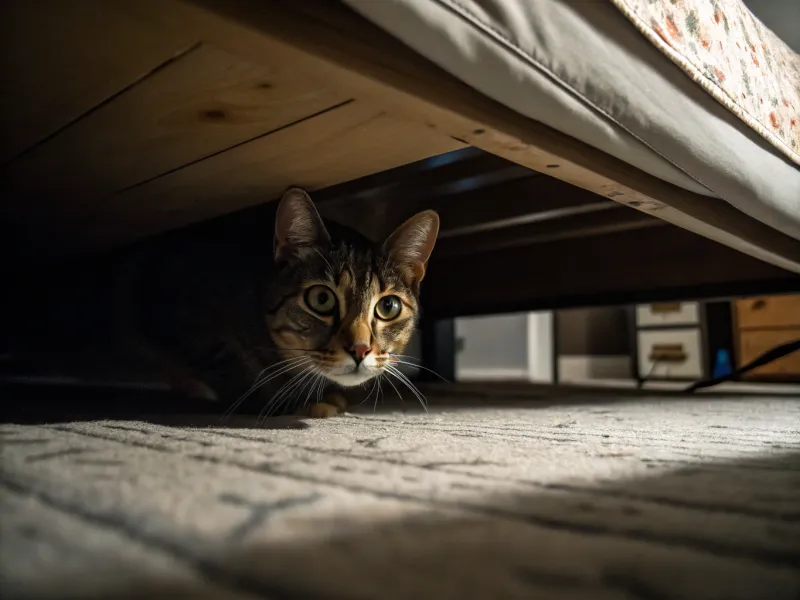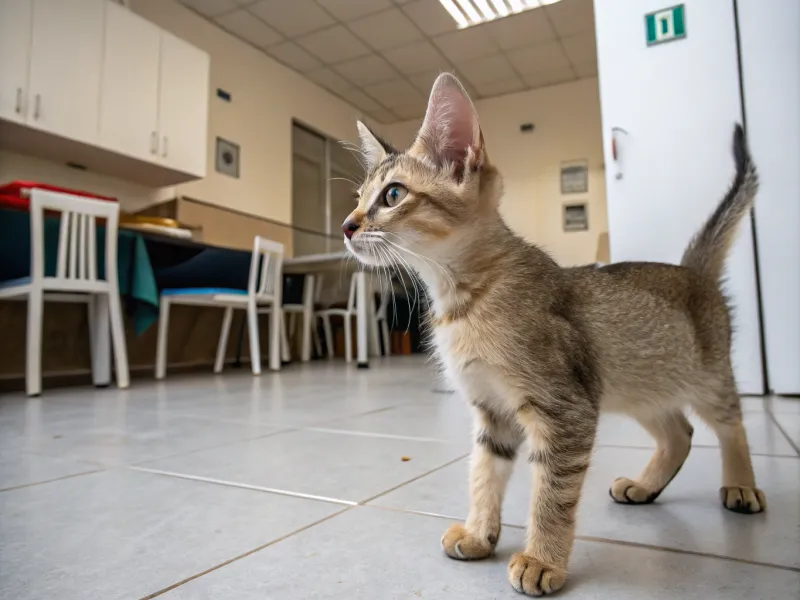📖 Table of Content:
- 1. Decreased Appetite
- 2. Lethargy
- 3. Hiding More Often
- 4. Decreased Grooming
- 5. Loss of Interest in Play
- 6. Excessive Vocalization
- 7. Aggression
- 8. Changes in Sleeping Patterns
- 9. Litter Box Issues
- 10. Changes in Vocal Tone
- 11. Clinginess
- 12. Lack of Response to Stimulation
- 13. Weight Loss
- 14. Changes in Behavior Toward People
- 15. Decreased Interaction with Other Pets
- 16. Hunched Posture or Reduced Movement
Cats, much like humans, can experience a range of emotions, including depression. Understanding the signs of depression in cats can help pet owners provide the necessary care and support.
Here are 16 signs to look out for to determine if your feline friend might be feeling down.
1. Decreased Appetite
If your cat seems to be eating less than usual, it might be a sign of depression. Cats are usually enthusiastic about their meals, so a sudden decrease in appetite is notable.
You might notice your cat sniffing the food but walking away without taking a bite. While it’s important to rule out other health issues, consider changes in your cat’s environment or routine.
Offering different food or enhancing mealtime with some interaction can sometimes rekindle their interest in eating.
2. Lethargy
A depressed cat may exhibit signs of lethargy, spending more time sleeping or lying around than active. This is contrary to their natural curiosity and playful nature.
If your cat is not showing interest in toys or activities they once enjoyed, it could be experiencing a lack of motivation. Such behavioral shifts should catch an owner’s attention.
Engaging your cat with new toys or interactive playtime might help restore some of its vigor and enthusiasm.
3. Hiding More Often
Cats usually hide when they feel threatened or unwell. If your cat is spending more time in hiding spots, it could indicate depression. Hiding is a common reaction to stress or sadness.
This behavior might be accompanied by a reluctance to interact with other pets or family members. Providing a safe and comforting environment can help alleviate this issue.
Encourage your cat to come out with gentle coaxing, or set up cozy spots in communal areas to help it feel secure.
4. Decreased Grooming
Grooming is an essential part of a cat’s daily routine, and a decline in grooming habits can signify depression. Cats take pride in their appearance, and neglecting this can indicate emotional distress.
You might notice your cat’s coat looking dull or matted. This change in behavior might point to a deeper issue affecting your pet’s wellbeing.
Regularly brushing your cat’s fur can help maintain its coat and serve as a bonding activity that might lift its spirits.
5. Loss of Interest in Play
Play is crucial for a cat’s mental and physical health. If your cat stops engaging with toys or games, it may be feeling depressed. Normally playful cats might suddenly ignore their favorite activities.
This change can be distressing for both pet and owner, as play is often a source of joy.
Try introducing new toys or different types of play to stimulate your cat’s interest. Interactive play sessions might reignite its curiosity and excitement.
6. Excessive Vocalization
While some cats are naturally talkative, excessive vocalization can be a sign of distress. A depressed cat might meow more frequently and in a different tone, indicating sadness or anxiety.
These vocalizations are attempts to communicate discomfort and should not be ignored. Pay attention to when your cat vocalizes more, as it might correlate with specific stressors.
Responding to your cat with attention and comforting words can help reassure it and reduce anxiety.
7. Aggression
Aggression in cats can sometimes stem from underlying depression. If your cat is displaying uncharacteristic aggression, it might be feeling emotionally unwell.
Watch for signs like hissing, swatting, or biting, which can indicate your cat is upset or in distress. Addressing this behavior calmly is important for both safety and understanding the root cause.
Consulting with a vet or animal behaviorist can provide insights into managing and alleviating aggressive tendencies.
8. Changes in Sleeping Patterns
Cats are known for their love of sleep, but significant changes in sleeping patterns can be a sign of depression. If your cat is sleeping more than usual or at odd hours, there might be cause for concern.
These changes could be accompanied by a lack of energy or enthusiasm. It’s essential to monitor how these patterns affect your cat’s overall behavior and health.
Encouraging regular playtimes or routines can help regulate its sleeping habits and improve mood.
9. Litter Box Issues
Unexpected issues with litter box usage can be a sign of distress or depression in cats. If your cat suddenly stops using its litter box, it’s important to address it promptly.
This behavior might be linked to anxiety or unhappiness, and ensuring the litter box is clean and accessible is crucial.
Understanding any changes in your cat’s environment or routine can help identify the cause and find solutions to the problem.
10. Changes in Vocal Tone
Changes in your cat’s vocal tone might indicate depression. If the usual cheerful chirps turn into mournful meows or growls, it could signify an emotional change.
Noticing when these changes occur can help pinpoint potential stressors in your cat’s life. Vocal changes are often a call for attention or comfort.
Spending more time with your cat and observing its habits can help you understand its needs better and provide necessary support.
11. Clinginess
Clinginess can be a sign of depression, where a cat seeks constant reassurance from its owner. If your cat suddenly sticks by your side more than usual, it might be feeling insecure or anxious.
This behavior includes following you from room to room and demanding attention persistently. Offering comfort and allowing your cat to be close can help alleviate its worries.
Encourage independent play as well to ensure a balanced and healthy relationship.
12. Lack of Response to Stimulation
A cat’s lack of response to stimulation, such as toys or sounds, can be a symptom of depression. Normally alert and curious, a depressed cat might show indifference.
This behavior signals a decrease in interest in the world around them, which can be concerning. Encouraging interaction through gentle play or introducing novel stimuli can help rekindle their curiosity.
Observing your cat’s reactions over time can provide insights into its emotional state and guide you in providing support.
13. Weight Loss
A noticeable drop in weight can be an alarming sign of depression in your cat. When cats feel down, they might lose interest in food, leading to weight loss.
You might find that your cat ignores its favorite treats or barely touches its meals. This change in appetite is often accompanied by a lack of energy, making your pet appear lethargic.
Monitoring your cat’s weight and eating habits is crucial. If you observe these changes, consider consulting a veterinarian. They can rule out other health issues and suggest dietary adjustments or interventions to improve your cat’s mood and health.
14. Changes in Behavior Toward People
If your usually affectionate cat starts avoiding contact, it might be experiencing depression. Cats often express their mood through their interactions with humans.
A depressed cat may hide, become withdrawn, or act out when approached. These behavioral changes indicate your pet is not feeling like its usual self.
Try to create a comforting environment and engage your cat with gentle play or soft words. Understanding and patience are key. However, if the behavior persists, it’s advisable to seek professional advice. Addressing these changes early can prevent further emotional stress for your furry friend.
15. Decreased Interaction with Other Pets
Cats are social creatures, and a sudden change in their interaction with other pets can signal depression. If your cat becomes less interested in playing or interacting with fellow animals, it could be feeling down. This withdrawal might manifest as ignoring or even hissing at pet companions.
Encourage social interaction by spending time with all your pets together, fostering a playful and inclusive environment. Providing toys and shared activities can also help.
If your cat continues to show disinterest, consulting a veterinarian can offer insights into potential stressors or health issues affecting its social behavior.
16. Hunched Posture or Reduced Movement
Known for their elegance and playfulness, cats usually move with ease, making a hunched posture or slow movements a sign of concern. A cat experiencing depression may appear slouched and uncomfortable. Along with this, a decrease in their activity level suggests a loss of interest in things they normally enjoy.
Providing a comfortable and stimulating environment can encourage movement. Observe your cat’s behavior closely, and ensure it has access to cozy resting spots.
If the posture or movement doesn’t improve, a vet visit can help determine if there’s an underlying health issue or provide strategies to boost your cat’s spirits.
















